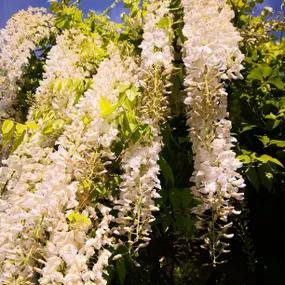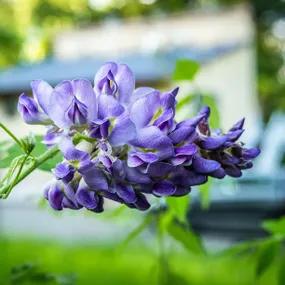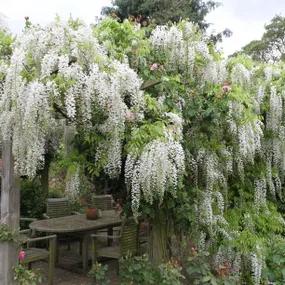Buying Climbing Wisteria Plants Online
Order Wisteria Vines Now For August Delivery
Gloriously abundant Wisteria flowers with their heady scent in late Spring are a must for any garden with space for them! There are many hybrid varieties to choose from with purple, blue or white flowers of differing lengths.
Their magnificent late spring blooms are seen scrambling up walls of many National Trust properties: a wonderful sight at Nymans and Sissinghurst.
Wisteria is easy to grow and pruning is simple.
Grow it on any wall or pergola that can provide enough support for the strong growth - preferably where the scent can be best appreciated on a warm spring day.
Whatever support you select needs to be strong and durable: never choose a drainpipe - it won't recover!
Wisteria is a quintessential part of British gardening, introduced to the UK the year after the battle of Waterloo, in 1816.
In Japan, they are called Fuji (no relation to the mountain) a name that conjures the image of the petals being 'blown off' in a breeze.
Wisteria are feminine: kimono sleeves emulate the shape of her flowers, and in Japanese art, the graceful lady Wisteria is paired with the noble, masculine pine tree.
It is a traditional cordage and basket weaving plant that was clearly in cultivation in 711 AD, when it is first mentioned in writing in the Kojiki, Records of Ancient Matters.
The mature stems made heavy-duty ropes, the flexible new stems have all manner of uses, and the flowers make dye.
Because wisteria is valuable as well as beautiful and long-lived, it became a go-to feature of Japanese family crests.
The oldest wisteria is 1200 years old if she's a day: “Ushizima Fuji”, at Tokaen temple gardens in Kasukabe, Saitama, planted by the Buddhist Reverend Kobo in the late 700's.
Ushizima Fuji's venerable old base is 9 metres around, but her spread is modest at 700m2 compared to the biggest area covered by wisteria on record, the Hermosa Avenue Vine in Sierra Madre, California, which shades more like 4000m2.
Wisteria floribunda varieties twine in a clockwise direction, and W. sinensis and W. brachybotrys wrap around their supports anti-clockwise.
Browse our range of climbing plants.
- Order now, pay later: we don't charge your card until before delivery
- When your order is ready: your mail order climbing plants are delivered by next working day courier (not the next working day after ordering!)
- Friendly support: if there is anything wrong with your plants when you inspect them, Contact Us within 5 working days
UK Grown, using peat free compost.




 2.webp)





.webp)
 1.webp)
